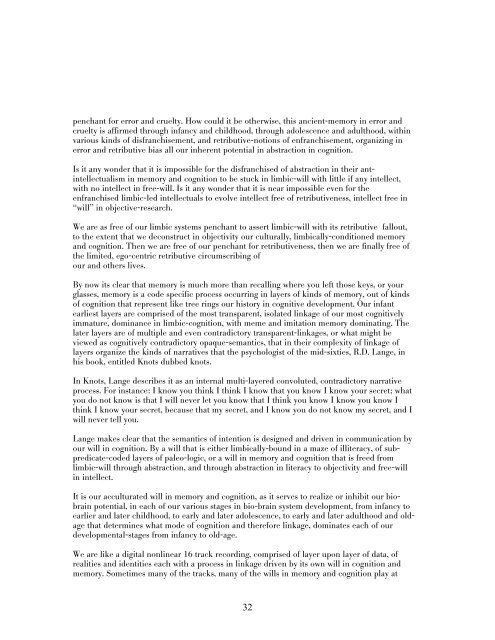SECTION 1 - via - School of Visual Arts
SECTION 1 - via - School of Visual Arts
SECTION 1 - via - School of Visual Arts
Create successful ePaper yourself
Turn your PDF publications into a flip-book with our unique Google optimized e-Paper software.
penchant for error and cruelty. How could it be otherwise, this ancient-memory in error and<br />
cruelty is affirmed through infancy and childhood, through adolescence and adulthood, within<br />
various kinds <strong>of</strong> disfranchisement, and retributive-notions <strong>of</strong> enfranchisement, organizing in<br />
error and retributive bias all our inherent potential in abstraction in cognition.<br />
Is it any wonder that it is impossible for the disfranchised <strong>of</strong> abstraction in their antintellectualism<br />
in memory and cognition to be stuck in limbic-will with little if any intellect,<br />
with no intellect in free-will. Is it any wonder that it is near impossible even for the<br />
enfranchised limbic-led intellectuals to evolve intellect free <strong>of</strong> retributiveness, intellect free in<br />
“will” in objective-research.<br />
We are as free <strong>of</strong> our limbic systems penchant to assert limbic-will with its retributive fallout,<br />
to the extent that we deconstruct in objectivity our culturally, limbically-conditioned memory<br />
and cognition. Then we are free <strong>of</strong> our penchant for retributiveness, then we are finally free <strong>of</strong><br />
the limited, ego-centric retributive circumscribing <strong>of</strong><br />
our and others lives.<br />
By now its clear that memory is much more than recalling where you left those keys, or your<br />
glasses, memory is a code specific process occurring in layers <strong>of</strong> kinds <strong>of</strong> memory, out <strong>of</strong> kinds<br />
<strong>of</strong> cognition that represent like tree rings our history in cognitive development. Our infant<br />
earliest layers are comprised <strong>of</strong> the most transparent, isolated linkage <strong>of</strong> our most cognitively<br />
immature, dominance in limbic-cognition, with meme and imitation memory dominating. The<br />
later layers are <strong>of</strong> multiple and even contradictory transparent-linkages, or what might be<br />
viewed as cognitively contradictory opaque-semantics, that in their complexity <strong>of</strong> linkage <strong>of</strong><br />
layers organize the kinds <strong>of</strong> narratives that the psychologist <strong>of</strong> the mid-sixties, R.D. Lange, in<br />
his book, entitled Knots dubbed knots.<br />
In Knots, Lange describes it as an internal multi-layered convoluted, contradictory narrative<br />
process. For instance: I know you think I think I know that you know I know your secret; what<br />
you do not know is that I will never let you know that I think you know I know you know I<br />
think I know your secret, because that my secret, and I know you do not know my secret, and I<br />
will never tell you.<br />
Lange makes clear that the semantics <strong>of</strong> intention is designed and driven in communication by<br />
our will in cognition. By a will that is either limbically-bound in a maze <strong>of</strong> illiteracy, <strong>of</strong> subpredicate-coded<br />
layers <strong>of</strong> paleo-logic, or a will in memory and cognition that is freed from<br />
limbic-will through abstraction, and through abstraction in literacy to objectivity and free-will<br />
in intellect.<br />
It is our acculturated will in memory and cognition, as it serves to realize or inhibit our biobrain<br />
potential, in each <strong>of</strong> our various stages in bio-brain system development, from infancy to<br />
earlier and later childhood, to early and later adolescence, to early and later adulthood and oldage<br />
that determines what mode <strong>of</strong> cognition and therefore linkage, dominates each <strong>of</strong> our<br />
developmental-stages from infancy to old-age.<br />
We are like a digital nonlinear 16 track recording, comprised <strong>of</strong> layer upon layer <strong>of</strong> data, <strong>of</strong><br />
realities and identities each with a process in linkage driven by its own will in cognition and<br />
memory. Sometimes many <strong>of</strong> the tracks, many <strong>of</strong> the wills in memory and cognition play at<br />
32








